It seems like eons ago that Proven Winners sent me some of their Berry Heavy Gold Ilex vertillicata (gold-colored winterberry holly). It was at least a decade ago, but those circa 2010-2012 shrub babies (in 4 pots) finally came into their own last fall, and I’m now eager to plant more. But only if I can find bigger plants, because who knows if I will be in this house another 12 years.
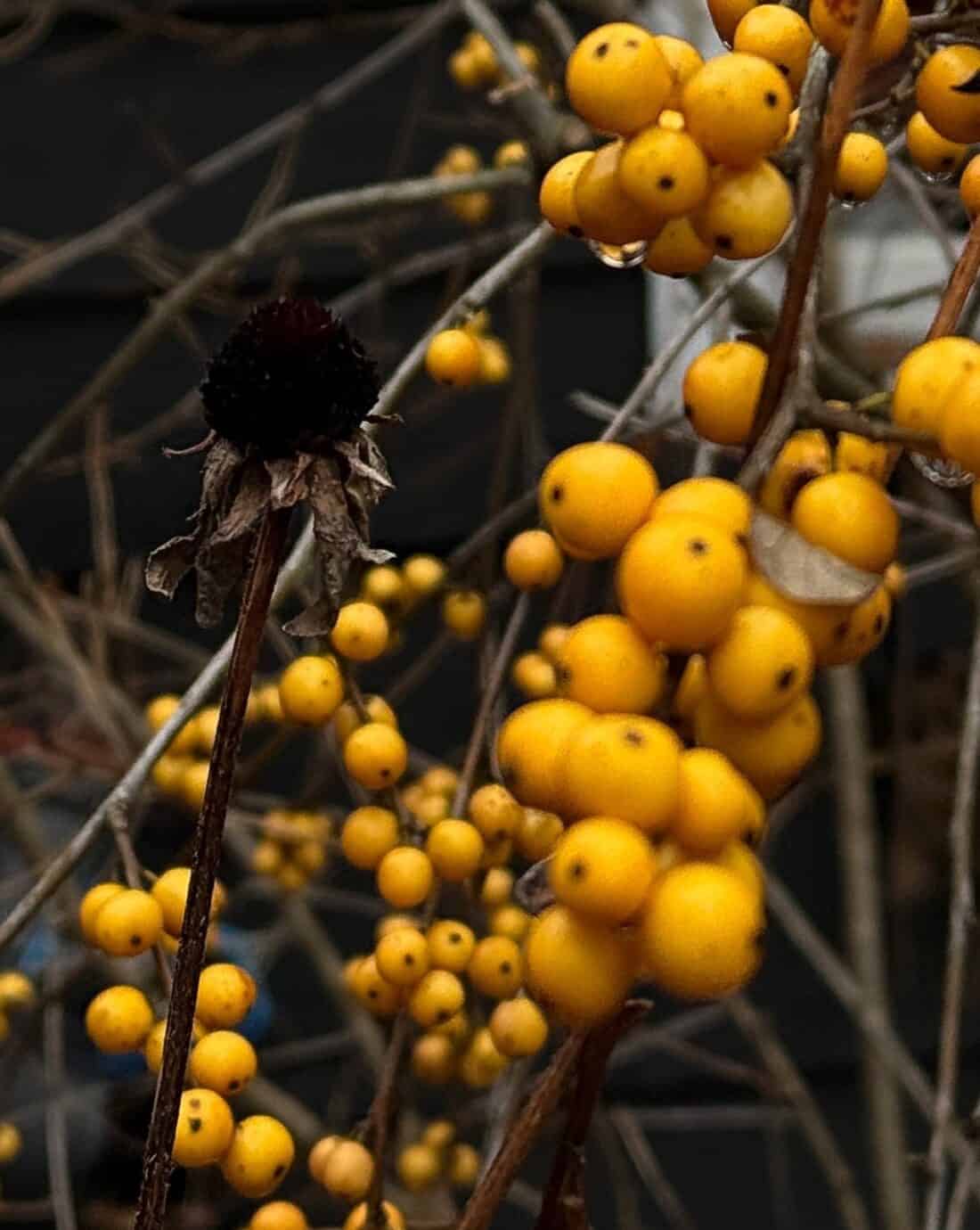
I’ve also coveted the wild native red winterberry that lives in the swamp coolee along the end of my road. It, too, is a variety of the native Ilex verticillata- (but I don’t know which one). Adding a native red winterberry to my landscape has been on my list for years, but given that good holiday foraging is so easy, I can always find something more rare to spend my space and dollars on.
Cutting Winterberry for Holiday Decorations
It is the berries that get me every time— I’d have certainly prioritized planting more hollies, if November and December were planting seasons. Ilex verticillata is best as its leaves turn yellow and then ultimately drop to leave branches with bright red (or yellow, or even orange in some cases) fruits attached to naked stems. They come alive exactly when everything else is dying or dead.
I buy berry stems at the holiday greens markets, but this year, having a healthy crop of my own berry heavy gold stems, I opted to decorate a little less traditionally (with yellow) for my Christmas arrangments.
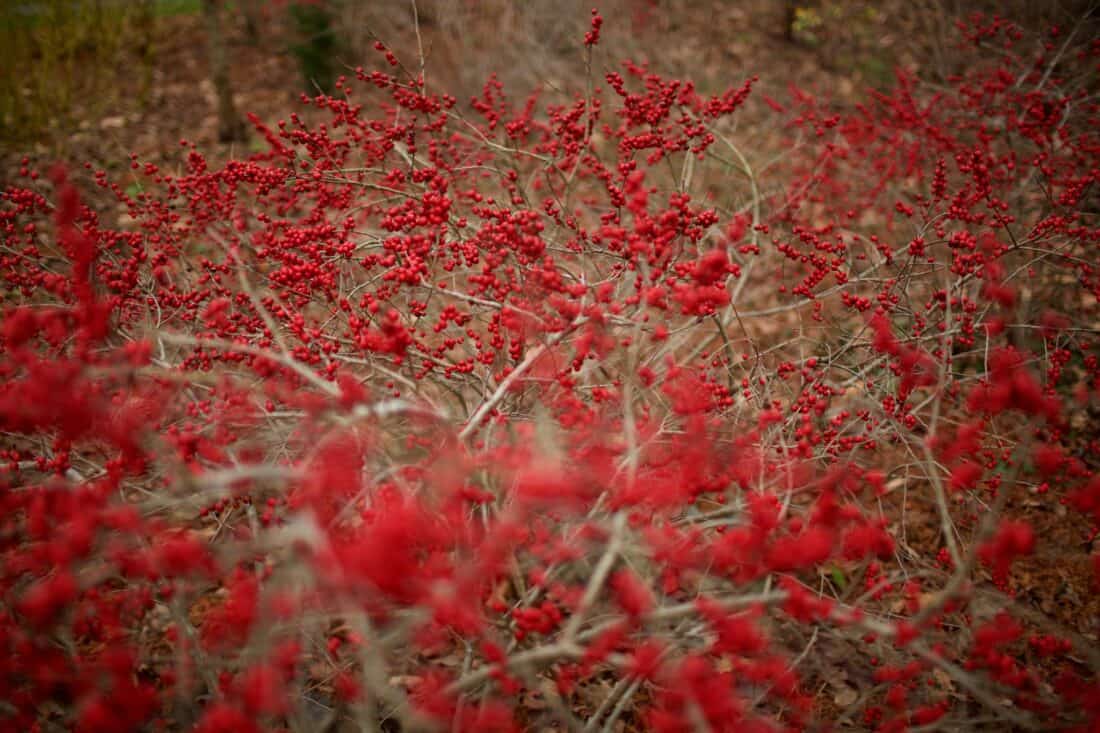
The gold-berried Ilex had a significantly better ability to stay on the stem. The floral market stems often lose at least a quarter of their little red beacons in the jostling of buying and getting them home. The rest barely make it through December 25th.
I threw away my gold stems – with shriveled but still gold berries on them, in late May (I picked them in November). They held up so much better – I wonder what the cause was.
Is it that perhaps the floral market berries are not so fresh? Are there varieties of red winterberry that have stronger connections and more prolific clusters of fruits? I need to investigate. Unfortunately, the cut stems are never labeled with plant tags.
For many years, I’ve wanted to experiment with treating the stem to see if I can get the berries to persist a little longer. Maybe a quick spray of thick hairspray, shellac, a glue spray, or something else would help preserve them for just a few weeks longer? Let me know if you have a solution.
Using Winterberry in Garden Design
Winterberry, loaded with bright red berries on slender twigs, is one of the prettiest shrubs in winter. It’s especially attractive standing proudly with snow on its branches.
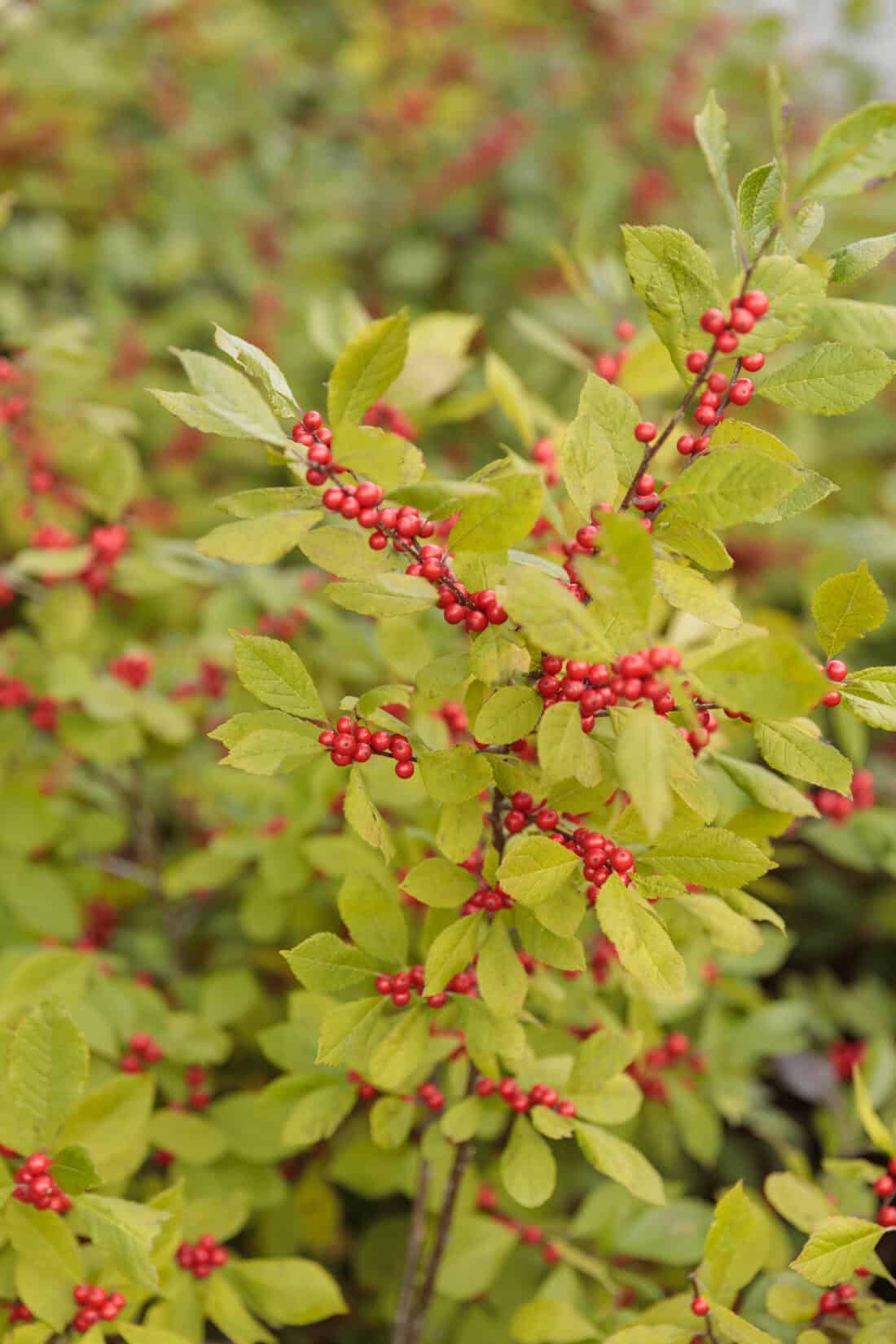
Here are a few design ideas for using winterberry (Ilex verticillata) in the landscape:
1. Winter Interest Focal Point
- Idea: Plant winterberry in a spot where it will be visible from a window or a frequently used outdoor space. The bright red berries will stand out against the winter landscape, providing color and visual interest during the drab months.
- Tip: Surround it with evergreens or grasses that can add contrasting textures and colors.
2. Seasonal Screening
- Idea: Use winterberry as a seasonal screen or hedge. Its dense foliage in summer and striking berries in winter make it perfect for creating a natural barrier.
- Tip: Mix male and female plants within the hedge to ensure berry production while maintaining coverage.
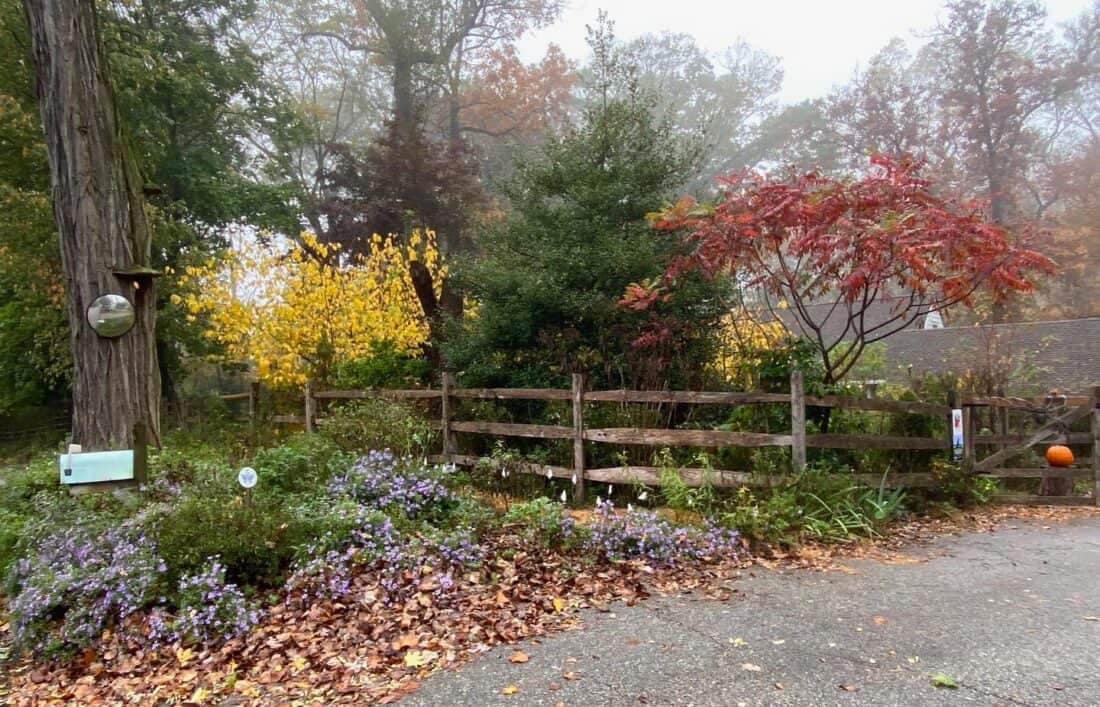
3. Mixed Borders
- Idea: Incorporate winterberry into mixed borders with other perennials and shrubs. Its ability to shine in different seasons makes it a great backbone plant.
- Tip: Pair it with plants like Clethra alnifolia (Summersweet) and Cornus sericea (Red Twig Dogwood) for a dynamic, multi-season display.
4. Rain Garden Accent
- Idea: Plant winterberry in a rain garden or other low-lying areas that collect water. Its preference for moist soil makes it an ideal choice for these spots.
- Tip: Combine with other moisture-loving natives like Iris versicolor (Blue Flag Iris) and Caltha palustris (Marsh Marigold) for a functional and beautiful rain garden.
5. Foundation Planting
- Idea: Use winterberry as part of a foundation planting to add structure and seasonal interest to your home’s exterior.
- Tip: Balance its height and berry display with lower-growing evergreens and ground covers for a layered effect.

6. Wildlife Garden
- Idea: Create a wildlife-friendly garden by planting winterberry alongside other native plants that provide food and shelter for birds and pollinators.
- Tip: Add bird feeders and bird baths nearby to create a haven for feathered friends, especially in winter when food is scarce. Winterberry in my neighborhood is the first to be harvested by wildlife – so make sure you plant plenty as well as other berried shrubs.
7. Container Planting
- Idea: Grow winterberries in large containers for a movable splash of color. This is especially useful for patios or entryways where you can showcase its berries up close.
- Tip: Ensure the containers have good drainage and keep the soil consistently moist.
About Ilex verticillata – winterberry:
Winterberry is a shrub that (depending on the variety) grows to 3-15 feet tall (and wide). It is one of a number of hollies that are deciduous, losing their leaves in the fall.
In wet sites, it will spread to form a dense thicket. The species naturally occurs in wetland habitats, but also on dry sand dunes and grassland. The berries are an important food resource for numerous species of birds. The berries were used by Native Americans for medicinal purposes, the origin of the name “fever bush”.
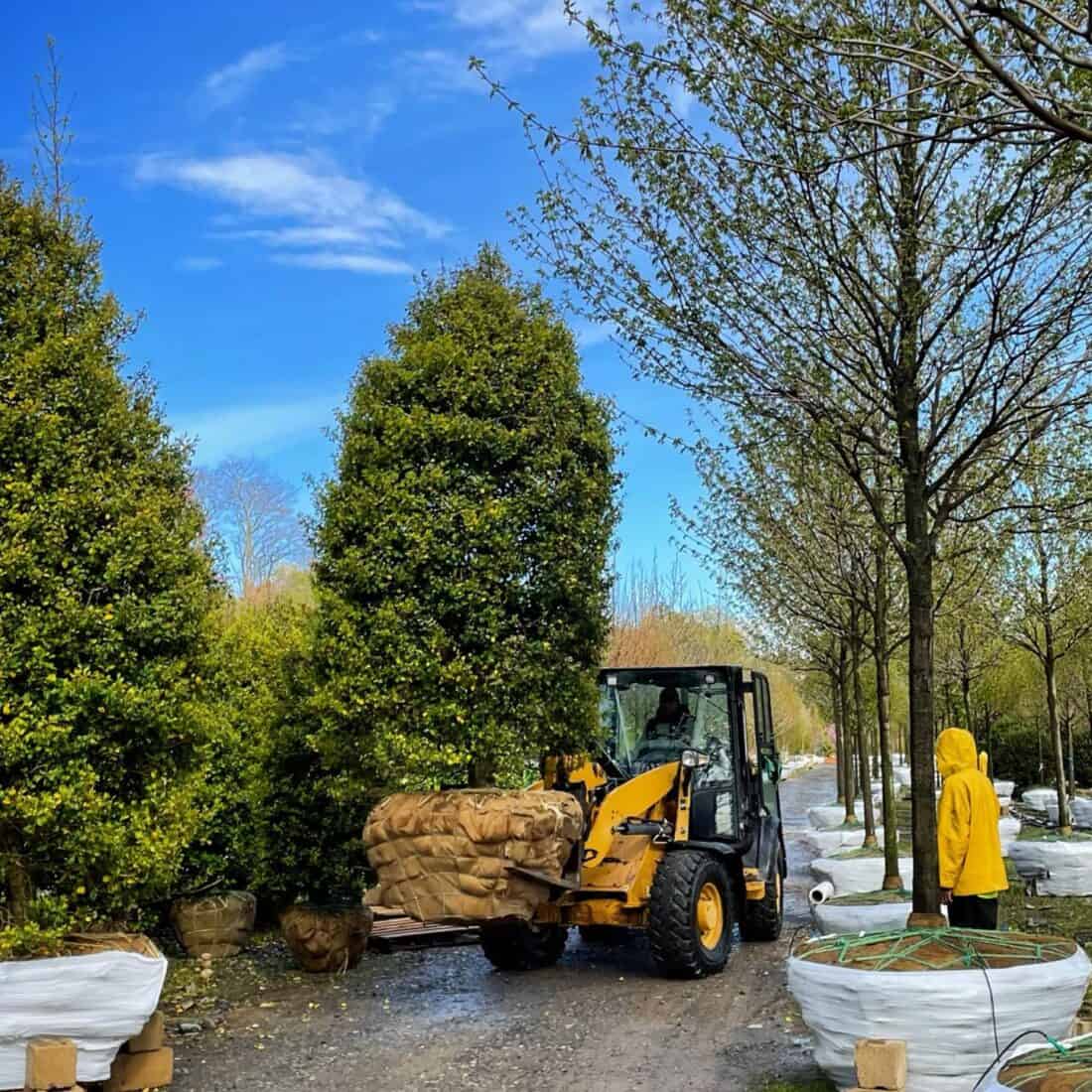
Other native Hollies – Ilex Opaca (and more)
About a year and a half ago, I became aware (while talking with a guest on a podcast) that there is a world of hollies – specifically, native American hollies – that gardeners here in the Northeast have no idea about.
The guest (who lived near Ashville, NC) mentioned that she was studying the genus of native hollies (Ilex opaca) and I remember thinking 1) Which holly are native to North America? and 2) She must not have a lot of time because I’m only aware of a few – Ilex meservae blue princess and prince (not native) – the deciduous hollies (mostly native), the Japanese hollies (also not native), and what else is there?
Well, I was wrong. There are A LOT of native hollies—hundreds, maybe more—and there is a ton of professionals (mostly in the South) that have bred a steady selection of new and better varieties all the time.
New England is at the very northern edge of the native range for Ilex opaca. If you are coastal or southern New England, you may be able to explore some of the
Learn more about the Holly Society of America
My Christmas decorations came alive!
A few years ago, I bought large bunches of winterberry holly (Ilex verticillata – no idea what variety) and put it in simple arrangements with variegated boxwood in vases all around my house. There was water in the bottom of each vessel, mostly to fend off quickly crisping box leaves that I didn’t want my two cats to catch wind of (a certain mess). I had weakly hoped that the water might also keep the berries plump but that didn’t work out. But what has worked is that roughly Ilex 25% of the stems have leaves now! I estimate my inadvertent propagating I will reward me with at least three of four new shrubs! Basically, I’ve created the beginnings of a hedge in my own kitchen while thinking I was spreading holiday cheer.
Over the years, I have also had great luck with accidentally propagating red twig dogwood from the holiday degoration cuttings. So, don’t be too eager to clear things out at the end of the season… you. might just be able to get some new plants as well as sources for future garden fresh holiday cuttings.
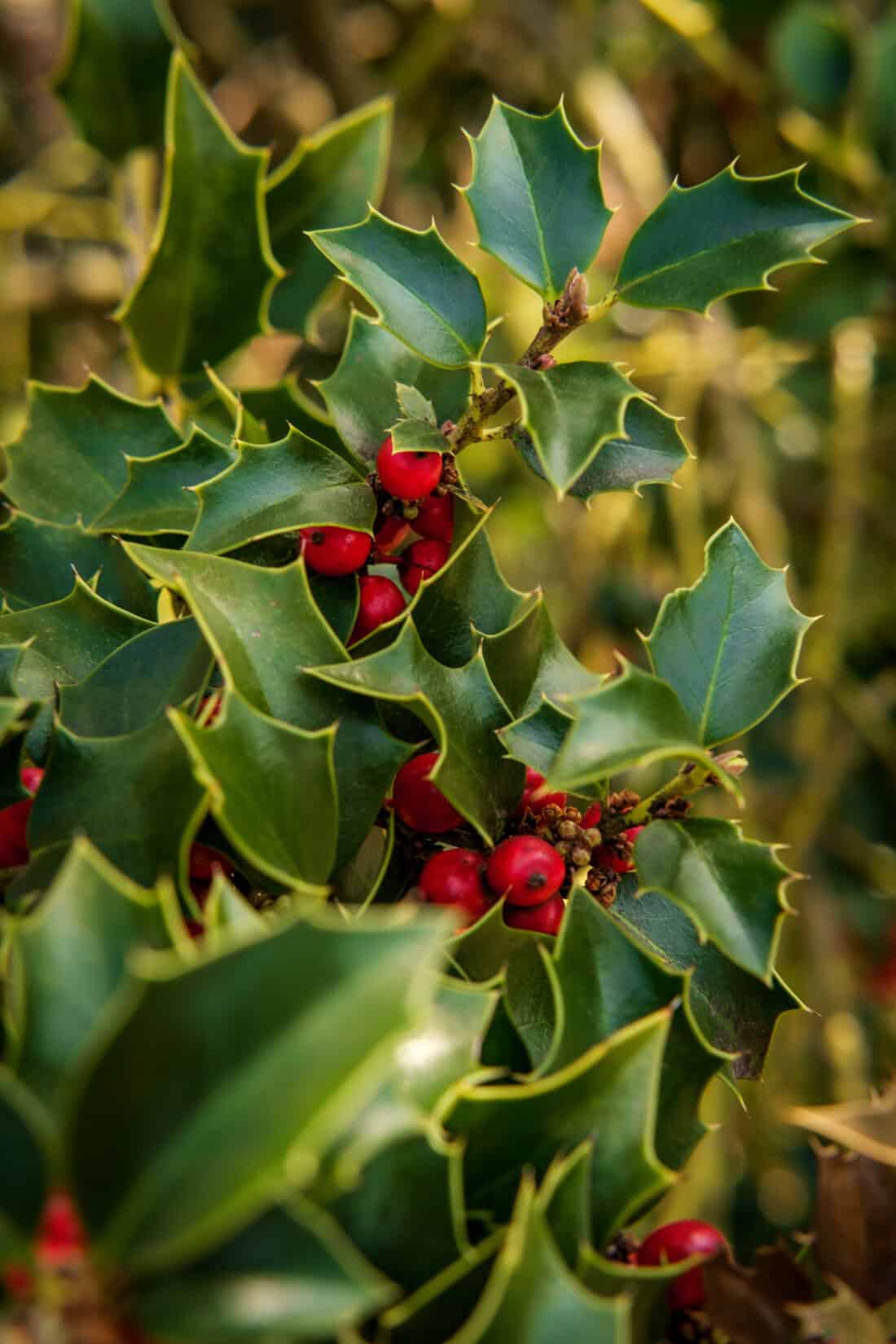
Rodney’s Notes on Ilex verticillata – Winterberry Landscaping
I have to admit that I made a mistake. I took for granted the beauty and appeal of the winterberry holly. Winterberry (Ilex verticillata) has gained popularity in recent years as an ornamental landscape plant. Since moving to coastal Maine, I see it growing all over the edges of woodlands and wet areas. As a person who loves plants, seeing an ornamental plant growing in its native habitat has a surreal quality to it. Seeing winterberry, for instance, shows you where a plant can survive and thrive, without being planted, pruned, fertilized, and watered.
Plus, with the fruit set, you can have free Christmas decorations for your home. The bright, red fruits of winterberry holly are a welcome, winter decoration to the outdoor garden and bedecked indoors.
Wild New England Holly
Last week, while riding down the road, we saw two pickup trucks pulled over alongside the road. As we passed, I saw that the trucks were already full of cut evergreen branches. I could also see why they had pulled over and parked.
There, beside the trucks, were a couple of folks pruning red-fruit-laden branches of wild winterberry hollies growing from the ditch banks.
Then the lightbulb went off. Any plant that would make people pull over is certainly worth more use in the landscape, especially one that is native to the eastern US.
Image From flickr.
Winterberry Hedging
Numerous cultivars of winterberry holly exist. These cultivars are broken down into three main groups. These groups are: northern US varieties which flower from May-June, southern US varieties which flower from June-July, and hybrid winterberries (Ilex verticillata x Ilex serrata). Knowing which plant your group falls in is important as you need to have the male flower at the same time as the female in order to achieve best fruit set in the fall.
image from Rodney Eason
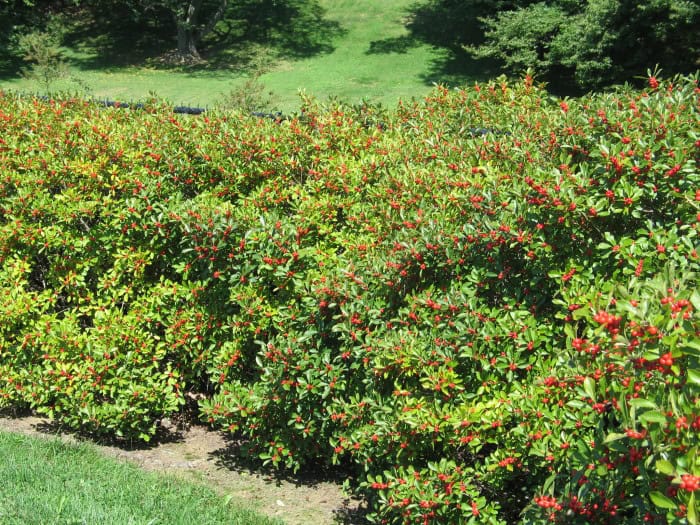
There are two important things to consider when selecting winterberry hollies. The first is that they are deciduous. Growing up in central North Carolina, outside of Raleigh, the holly I most often saw in the woods was the evergreen American holly, Ilex opaca. I did not know that this plant had a smaller relative that lost its leaves, until we had to learn Ilex verticillata in our college plant identification classes. The second thing to know is that they are dioecious. Dioecious literally means “two households” and in this case, that there are male and female plants. So, if you want the beautiful berries for this queen of the winter landscape, you have to plant a male counterpart nearby. The normal ratio is one male pollinator for every 12-15 female plants.
Thankfully, quite a bit of research has been done on winterberries. Longwood Gardens conducted a 20 year trial of different winterberries and published their findings here. My favorites include: ‘Sparkleberry‘ (a hybrid), ‘Winter Red‘ (a southern selection), and ‘Red Sprite’ (a northern selection and above). For each female plant, there is an appropriate male.
The Manual of Woody Landscape Plants by Dr. Michael A. Dirr is a valuable reference for sorting out which male pollinator is best for which female plant. Often, the plant breeders have adopted studly names for the male pollinators such as: ‘Apollo,’ ‘Jim Dandy,’ ‘Southern Gentleman,’ and my favorite ‘Rhett Butler’ who of course is the pollinator for the female ‘Scarlet O’Hara.’
As for planting conditions, winterberry grows best in a slightly acidic soil (4.5-6.5 pH) that stays continuously moist, yet well drained. It will survive in drier sites but will struggle and look thin, chlorotic, and produce less fruit.
Do you have winterberry holly in your garden? If so, which one and do you like it?
– Rodney

+comments+